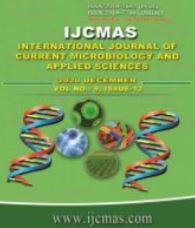


 National Academy of Agricultural Sciences (NAAS)
National Academy of Agricultural Sciences (NAAS)

|
PRINT ISSN : 2319-7692
Online ISSN : 2319-7706 Issues : 12 per year Publisher : Excellent Publishers Email : editorijcmas@gmail.com / submit@ijcmas.com Editor-in-chief: Dr.M.Prakash Index Copernicus ICV 2018: 95.39 NAAS RATING 2020: 5.38 |
Sorghum (Sorghum bicolor) is a gluten free, whole grain packed with complex carbohydrates and minerals. Its consumption is limited due to lack of adoption in diversified food products and easy availability of other chief cereals. With this background a study was undertaken to process sorghum grain by malting technique and to incorporate its flour in bread preparation. Grain sorghum samples were procured, studied for physical characteristics and processed by malting at different periods, then ground into flour and analyzed for nutritional composition. Nutritionally best variation of malted sorghum was selected for incorporation in bread preparation by replacing refined wheat flour at 10,20 and 30 per cent. Further prepared bread samples were subjected for sensory analysis and computed its nutritional value. Findings highlighted that, density of the sorghum grain is 1.17g/ml. Period of malting did not affected flour recovery. Nutrient composition include moisture, protein, fat, ash, crude fiber, carbohydrate and energy varied from 6- 6.7 per cent, 9.37 to 11.37, 1.87 to 3.27, 1 to 1.12, 2.0 to 2.4, 79.5 to 73.5g/100g and 369 to 375.76 Kcal/100g Respectively. Among the flour samples, 72hr malted sorghum flour had good nutritional value which was further utilized for incorporation in bread preparation. Among the different incorporation levels, 10 per cent was found to be best accepted with good sensory scores. Incorporation of sorghum flour has slightly improved nutritional value of prepared bread. In this regard, future research must be focused towards increasing the incorporation level of malted sorghum flour instead of wheat flour to develop low gluten food products, which reduces demand for wheat and encourage the formers to grow this nutritionally important millet.
 |
 |
 |
 |
 |